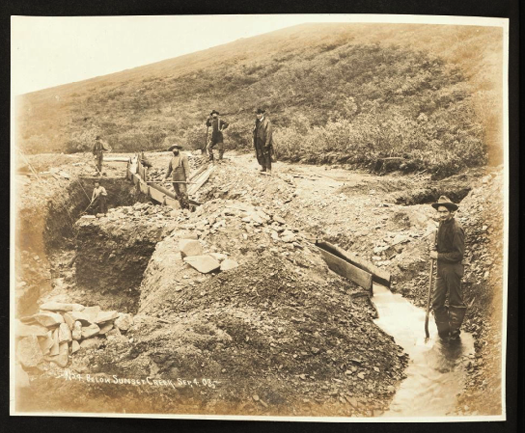

It was too steep for pack animals, and prospectors had to pack their equipment and supplies to the top. The climb to the Chilkoot Pass was steep and hazardous, rising a thousand feet in the last half mile (300 m in 800 m). It was put in place to avert shortages like those that had occurred in the previous two winters in Dawson City. At the top of the passes, the stampeders encountered a Mountie post that enforced that regulation. Stampeders had to carry a year's supply of goods - about a ton, more than half of it food - over the passes to be allowed to enter Canada. Here, some 25 to 35 grueling miles (40 - 56 km) from where they landed, prospectors built rafts and boats that would take them the final 500-plus miles (800-plus km) down the Yukon to Dawson City, near the gold fields. From these towns they traveled the Chilkoot Trail and crossed the Chilkoot Pass, or they hiked up to the White Pass into the Yukon Territory and proceeded thence to Lake Lindeman or Lake Bennett, the headwaters of the Yukon River. Most prospectors landed at Skagway, Alaska, or the adjacent town of Dyea, Alaska, both located at the head of the Lynn Canal. In 1898, the population in the Klondike may have reached 40,000, which threatened to cause a famine. News reached the United States in July 1897, when the first successful prospectors arrived in San Francisco on July 15 and in Seattle on July 17, setting off the Klondike stampede. Robert Henderson, who was mining only a few miles away over the hill, only found out about the discovery after the rich creeks had been all staked. The news spread to other mining camps in the Yukon River valley, and the Bonanza, Eldorado and Hunker Creeks were rapidly staked by miners who had been previously working creeks and sandbars on the Fortymile and Stewart Rivers. The group agreed to this because they felt that other miners would be reluctant to recognize a claim made by an Indian, given the strong racist attitudes of the time. George Carmack was officially credited for the discovery because the "discovery" claim was staked in his name. It is now generally accepted that Skookum Jim made the actual discovery, but some accounts say that it was Kate Carmack. On August 16, 1896, the party discovered rich placer gold deposits in Bonanza (Rabbit) Creek. The group then headed a few miles up the Klondike River to Rabbit Creek (now Bonanza Creek) to hunt moose. Henderson told George Carmack about where he was mining and that he did not want any "Siwashes" (meaning Indians) near him. After meeting up with George and Kate, who were fishing for salmon at the mouth of the Klondike River, they ran into Nova Scotian Robert Henderson who had been mining gold on the Indian River, just south of the Klondike.

The party included Skookum Jim, Skookum Jim's cousin known as Dawson Charlie (or sometimes Tagish Charlie) and his nephew Patsy Henderson. In August 1896, three people led by Skookum Jim Mason (a member of the Tagish nation whose birth name was Keish) headed north, down the Yukon River from the Carcross area, looking for his sister Kate and her husband George Carmack.


 0 kommentar(er)
0 kommentar(er)
